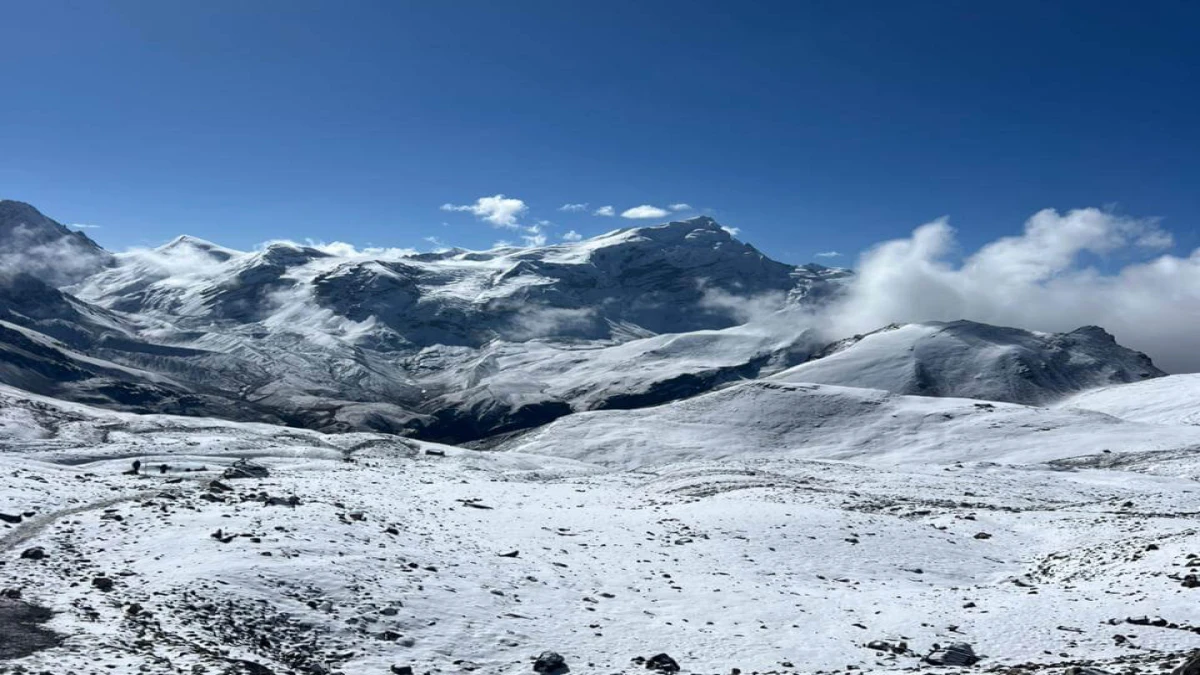Why should you choose Off-Season Trekking in Nepal?
Trekking in Nepal is something everyone loves. But trekking during the off-season in Nepal, whether it's Winter or Monsoon, is a real adventure. The trekking trails feel peaceful in these seasons. Tourists are fewer, the hotels often provide discounts, and the chance you get to experience the Nepali culture even closer makes this trek unique. During the Monsoon Season, trekking trails and the valleys are lush green and feel heart-warming in the fresh air. While in Winter Season, the mountains are covered by snow and look stunning. Both these season offers unforgettable memories.
Off-Season Trekking: Monsoon vs Winter
Trekking in Nepal gives you a completely different experience from peak-season treks. Monsoon and Winter both has its own unique charm and Challanges. Here’s a detailed comparison:
Trekking in Nepal during the Monsoon season
- Scenery: Trails come alive with lush green forest, flowing rivers, and blooming flora.
- Trails to Explore: You can visit rain-shadow areas where rain is lighter and trails are safer.
- Trail Experience: Peaceful trekking on quiet paths, surrounded by vibrant nature, mist, and waterfalls.
Trekking in Nepal during the Winter season
- Scenery: Trails are filled with snow, and the Himalayan peaks appear stunning with snow under blue skies.
- Trails to Explore: You can choose lower elevations or some high passes too for best views.
- Trail Experience: The trail is less crowded, teahouses are peaceful, sunrise and sunsets are magical over snow-capped peaks.
| Feature | Monsoon Trekking | Winter Trekking |
| Landscape | Lush green valleys, rivers, and waterfalls | Snow-capped mountains, clear skies |
| Weather | Rainy, humid | Cold, dry, crisp air |
| Trails | Rain-shadow places for safety | Lower elevation places for safety |
| Photography | Greenery and waterfalls | Snowy peaks, sunrise and sunset views |
| Crowds | Fewer tourists | Fewer tourists |
Whether you choose monsoon trekking for vibrant green scenery or winter trekking for snowy Himalayas views, off-season trekking in Nepal gives you the peaceful trails, an authentic cultural experience, and an unforgettable journey.
Best Routes for Monsoon Trekking
In most of the Treks in Nepal, the trails are slippery and heavy rain makes your trek difficult. But, there are some Monsoon trekking routes in Nepal which are safe and spectacular:
- Upper Mustang Trek:Upper Mustang lies in a rain-shadow region. So this is a safe trek during the Monsoon Season. Upper Mustang is known for its Tibetan culture and desert-like landscapes.
- Upper Dolpo Trek: Upper Dolpo is also located in the rain shadow of the Annapurna and Dhaulagiri ranges. So, you can do the Upper Dolpo Trek even in the Monsoon season. Trekking in the Dolpo region offers you natural beauty as well as tradition.
- Nar Phu Valley: This place is perfect for peaceful trekking with very few tourists. Trek to Nar Phu Valley explores remote villages, Tibetan-like people, forest, Buddhist Gumbas, and majestic mountains. Nar Phu lies in the rain-shadow area, but the monsoon can still make the route slippery. You can still trek in Nar Phu Valley during the Monsoon.
Best Routes for Winter Trekking
Winter brings cold in the Himalayas, but if you are adventurous and crazy for trekking, then winter is definitely a good option. The mountains are covered by snow, fresh air, and skies are clear during this season. Some treks you can do in Nepal during the Winter season are:
- Everest Base Camp Trek (EBC):Everest Base Camp Trek during Winter Season brings peaceful trails with fewer Tourists. The Himalayan Peaks looks breathtaking with the snow. Winter is definitely the best season in EBC for the views and amazing photography opportunities.
- Annapurna Base Camp Trek (ABC): Annapurna Base Camp Trek during Winter season is best for people who can bear cold and is adventurous. Those snow-covered peaks look stunning and the trail is less crowded and peaceful.
- Lower Elevation Trails: The lower elevation trekking trails like Helambu, Langtang Valley are good for beginners or for people who are avoiding extreme cold.
Advantages and Challenges of Trekking During the Off-season
Trekking in Nepal during off-season, whether it’s monsoon or Winter, offers a completely different experience compared to peak seasons. Here is the breakdown of advantages and challenges during off-season trekking.
Advantages:
Fewer tourists & Quiet trails: Off-season trekking means you can enjoy the peaceful trails without the crowds that peak season brings.
Unique Landscapes: During monsoon the trails are surrounded by lush green forests, blooming flora, and vibrant valleys. In winter the mountains are covered by snow, the sky is clear, and panoramic views of those mountains make the trek successful.
Cultural Immersion: With fewer trekkers, you’ll get more authentic interaction with local villagers, you can also experience home-cooked Nepali meals, and you can witness local traditions without rushing.
Lower Cost: Lodges and teahouses ofen offer discounted rates during off-season trekking in Nepal, making it ideal for budget travelers.
Challenges:
Weather Challenges: Monsoon brings Slippery Trails, landslides, and occasional heavy rain can make trekking risky. While winter brings cold temperatures and snow that can make high-altitude treks challenging.
Limited Accessibility: Some trails or passes may be closed during heavy snowfall or rainy season.
Wildlife & Environmental Hazards: Leeches during monsoon in forests and icy paths in winter is common, so you need extra caution and preparation.
Travel Disruptions: Flight delays, road closures, or muddy paths can affect your itinerary.
Is off-season Trekking in Nepal Safe?
Yes, off-season trekking in Nepal is safe if you plan carefully. Choose the suitable trail, carry the right gear, and follow the guide advice. The off-season allows you to enjoy the peaceful trails, authentic cultural experiences, and breathtaking scenery without compromising safety.
Safety Tips for Off-Season Trekking
- During Monsoon choose the Right routes like rain-shadow trekking routes to avoid heavy rainfall and landslides.
- During Winter stick to lower elevation trails like Helambu, Langtang Valley or Ghorepani Poon Hill.
- Check the Weather and keep track of weather updates and local conditions daily.
- Avoid trekking during heavy stroms or unsafe conditions.
- Carry proper gear for monsoon and winter.
- Hire a Guide, because it increases safety, helps with navigation, and provides cultural insights.
- Off-season trekking might involve flights or road delays due to weather so be prepared dor Delays.
- Maintain your Physical and Mental Health, keep yourself hydrated and listen to your body.
Packing Essentials for Monsoon and Winter Treks
Monsoon Trekking Essentials
During the monsoon season, trekking in Nepal becomes challenging due to wet, muddy, and slippery trails. So you’ll need:
- Waterproof jacket & pants: To keep you dry in heavy rains.
- Trekking boots with good grip: Prevent slipping on muddy paths.
- Leech socks: Essential in forested areas because leech is common during Monsoons.
- Trekking poles: Help to maintain balance on slippery trails.
- Rain cover for backpack: Protects your gear from rain.
- Quick-dry clothing: Comfortable and dries fast when it is wet.
- Headlamp or flashlight: Useful during foggy or rainy conditions.
Winter Trekking Essentials
Winter treks can be cold and snowy, especially at high altitudes. So there are some essential items that you may need:
- Thermal layers: Base layers to keep warm.
- Down jacket: It must be lightweight and insulated.
- Gloves, hat, scarf: Protect extremities from frostbite.
- Insulated trekking boots: To keep feet warm on snow-covered trails.
- Sleeping bag: To keep you extra warm during low temperatures.
- Sunglasses & sunscreen: Snow reflects sunlight, so you need to protect eyes and skin.
Essentials for Both Seasons
Some gear is important year-round, whether trekking in monsoon or winter:
- First-aid kit: For minor injuries or altitude sickness.
- Water bottle & purification tablets: Stay hydrated and safe.
- Snacks & energy bars: This gives you quick energy during long treks.
- Personal hygiene items: Wet wipes, hand sanitizer, toiletries.
- Map & compass or GPS: You can carry it even if you’re trekking with a guide.
Packing Tips for Off-Season Trekking
- Avoid carrying unnecessary weight, pack light but smart.
- Keep important items in waterproof bags.
- Layer your clothes so that it is easier to adjust to changing temperatures.
- Always check weather forecast and trail conditions before packing.
Top Mistakes to Avoid During Off-Season Trekking
Trekking during the off-season in Nepal can be magical, but some common mistakes can turn your adventure into a challenge. Here’s what to what out for:
- Skipping Trekking Permits and TIMS Card: Some trekkers forget or skip trekking permits, which are mandatory for most of the trails.
- Insufficient Gear: Off-season trekking requires appropriate gear. Enough layers and gear for both Winter and Monsoon seasons.
- Ignoring Weather Conditions: The weather might be harsh during off-season treks, so check the weather forecasts and trail conditions daily.
- Understimating Trail Difficulty: Trails during off-season might be slippery, muddy, or snowy. This makes the trek harder than you expect, so plan according to your fitness level.
- Not Planning For Travel Delays: Weather can delay your flights, roads, and trails. So, keep an extra day in your itinerary so that you can avoid stress.
- Neglecting Health and Hydration: The upper elevation treks can give you Altitude sickness, so drink plenty of water, listen to your body, take short breaks and acclimatize properly on high-altitude treks.
Avoid these mistake and your off-season trekking in Nepal can be a safe, comfortable, and unforgettable adventure. Proper gear, permits, weather, and planning make all the difference.
Conclusion: Why Should You Try Off-Season Trekking in Nepal
Most people dream of trekking in Nepal during Autumn or Spring Seasons. These season brings clear weather, skies and views. But the truth is off-season trekking in Nepal has its own rare beauty.
Monsoon brings lush green valleys and trails. Yes, you’ll deal with rain, mud, and leeches, but in return, you’ll experience a raw, authentic side of Nepal that most tourists never see. In winter, the snowy mountains look like they are wearing a grand white crown. The skies are crystal clear and the villages feel calm and cozy. While some high passes may get close due to snow, lower-altitude treks become peaceful havens where you can connect deeply with nature and local culture.
So yes, trekking during the off-season in Nepal has challenges, unpredictable weather, harder trails, and colder nights, but with the right preparation, gear, and mindset, it can be the adventure of a lifetime.
If you’re planning an off-season trek in Nepal, partnering with an experienced local agency like Himalayan Partner ensures a safe and smooth journey. They provide guides, porters, permits, and itinerary planning, so you can focus on enjoying the lush monsoon valleys or snowy winter trails.





